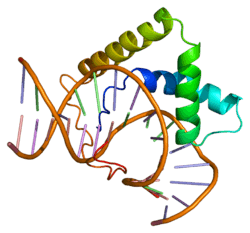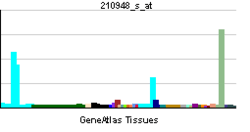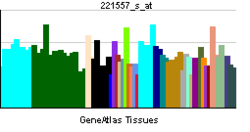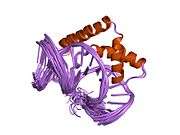Lymphoid enhancer-binding factor 1
| View/Edit Human | View/Edit Mouse |
Lymphoid enhancer-binding factor 1 (LEF1) is a protein that in humans is encoded by the LEF1 gene.[4]
Function
Lymphoid enhancer-binding factor-1 (LEF1) is a 48-kD nuclear protein that is expressed in pre-B and T cells. It binds to a functionally important site in the T-cell receptor-alpha (TCRA) enhancer and confers maximal enhancer activity. LEF1 belongs to a family of regulatory proteins that share homology with high mobility group protein-1 (HMG1).[5]
Clinical significance
LEF1 is highly overexpressed and associated with disease progression and poor prognosis in B-cell chronic lymphocytic leukemia.[6] It is also a promising potential drug target.[7]
Interactions
Lymphoid enhancer-binding factor 1 has been shown to interact with:
References
- ↑ "Diseases that are genetically associated with LEF1 view/edit references on wikidata".
- ↑ "Human PubMed Reference:".
- ↑ "Mouse PubMed Reference:".
- ↑ Milatovich A, Travis A, Grosschedl R, Francke U (Mar 1992). "Gene for lymphoid enhancer-binding factor 1 (LEF1) mapped to human chromosome 4 (q23-q25) and mouse chromosome 3 near Egf". Genomics. 11 (4): 1040–8. doi:10.1016/0888-7543(91)90030-I. PMID 1783375.
- ↑ "Entrez Gene: LEF1 lymphoid enhancer-binding factor 1".
- ↑ Erdfelder F, Hertweck M, Filipovich A, Uhrmacher S, Kreuzer KA (2010). "High lymphoid enhancer- binding factor-1 expression is associated with disease progression and poor prognosis in chronic lymphocytic leukemia". Hematology Reports. 2 (1). doi:10.4081/hr.2010.e3.
- ↑ Gandhirajan RK, Staib PA, Minke K, Gehrke I, Plickert G, Schlösser A, Schmitt EK, Hallek M, Kreuzer KA (April 2010). "Small molecule inhibitors of Wnt/beta-catenin/lef-1 signaling induces apoptosis in chronic lymphocytic leukemia cells in vitro and in vivo". Neoplasia. 12 (4): 326–35. PMC 2847740
 . PMID 20360943.
. PMID 20360943. - ↑ Boras K, Hamel PA (January 2002). "Alx4 binding to LEF-1 regulates N-CAM promoter activity". J. Biol. Chem. 277 (2): 1120–7. doi:10.1074/jbc.M109912200. PMID 11696550.
- ↑ Lutterbach B, Westendorf JJ, Linggi B, Isaac S, Seto E, Hiebert SW (January 2000). "A mechanism of repression by acute myeloid leukemia-1, the target of multiple chromosomal translocations in acute leukemia". J. Biol. Chem. 275 (1): 651–6. doi:10.1074/jbc.275.1.651. PMID 10617663.
- ↑ Edlund S, Lee SY, Grimsby S, Zhang S, Aspenström P, Heldin CH, Landström M (February 2005). "Interaction between Smad7 and beta-catenin: importance for transforming growth factor beta-induced apoptosis". Mol. Cell. Biol. 25 (4): 1475–88. doi:10.1128/MCB.25.4.1475-1488.2005. PMC 548008
 . PMID 15684397.
. PMID 15684397. - ↑ Grueneberg DA, Pablo L, Hu KQ, August P, Weng Z, Papkoff J (June 2003). "A functional screen in human cells identifies UBF2 as an RNA polymerase II transcription factor that enhances the beta-catenin signaling pathway". Mol. Cell. Biol. 23 (11): 3936–50. doi:10.1128/MCB.23.11.3936-3950.2003. PMC 155208
 . PMID 12748295.
. PMID 12748295. - ↑ Behrens J, von Kries JP, Kühl M, Bruhn L, Wedlich D, Grosschedl R, Birchmeier W (August 1996). "Functional interaction of beta-catenin with the transcription factor LEF-1". Nature. 382 (6592): 638–42. doi:10.1038/382638a0. PMID 8757136.
- 1 2 3 Labbé E, Letamendia A, Attisano L (July 2000). "Association of Smads with lymphoid enhancer binding factor 1/T cell-specific factor mediates cooperative signaling by the transforming growth factor-beta and wnt pathways". Proc. Natl. Acad. Sci. U.S.A. 97 (15): 8358–63. doi:10.1073/pnas.150152697. PMC 26952
 . PMID 10890911.
. PMID 10890911. - ↑ Hecht A, Stemmler MP (February 2003). "Identification of a promoter-specific transcriptional activation domain at the C terminus of the Wnt effector protein T-cell factor 4". J. Biol. Chem. 278 (6): 3776–85. doi:10.1074/jbc.M210081200. PMID 12446687.
- ↑ Yasumoto K, Takeda K, Saito H, Watanabe K, Takahashi K, Shibahara S (June 2002). "Microphthalmia-associated transcription factor interacts with LEF-1, a mediator of Wnt signaling". EMBO J. 21 (11): 2703–14. doi:10.1093/emboj/21.11.2703. PMC 126018
 . PMID 12032083.
. PMID 12032083. - ↑ Sachdev S, Bruhn L, Sieber H, Pichler A, Melchior F, Grosschedl R (December 2001). "PIASy, a nuclear matrix-associated SUMO E3 ligase, represses LEF1 activity by sequestration into nuclear bodies". Genes Dev. 15 (23): 3088–103. doi:10.1101/gad.944801. PMC 312834
 . PMID 11731474.
. PMID 11731474.
Further reading
- Waterman ML (2004). "Lymphoid enhancer factor/T cell factor expression in colorectal cancer.". Cancer Metastasis Rev. 23 (1–2): 41–52. doi:10.1023/A:1025858928620. PMID 15000148.
- Skokowa J, Welte K (2007). "LEF-1 is a decisive transcription factor in neutrophil granulopoiesis". Ann. N. Y. Acad. Sci. 1106: 143–51. doi:10.1196/annals.1392.012. PMID 17360796.
- Travis A, Amsterdam A, Belanger C, Grosschedl R (1991). "LEF-1, a gene encoding a lymphoid-specific protein with an HMG domain, regulates T-cell receptor alpha enhancer function [corrected]". Genes Dev. 5 (5): 880–94. doi:10.1101/gad.5.5.880. PMID 1827423.
- van de Wetering M, Oosterwegel M, Dooijes D, Clevers H (1991). "Identification and cloning of TCF-1, a T lymphocyte-specific transcription factor containing a sequence-specific HMG box". EMBO J. 10 (1): 123–32. PMC 452620
 . PMID 1989880.
. PMID 1989880. - Waterman ML, Fischer WH, Jones KA (1991). "A thymus-specific member of the HMG protein family regulates the human T cell receptor C alpha enhancer". Genes Dev. 5 (4): 656–69. doi:10.1101/gad.5.4.656. PMID 2010090.
- Zhou P, Byrne C, Jacobs J, Fuchs E (1995). "Lymphoid enhancer factor 1 directs hair follicle patterning and epithelial cell fate". Genes Dev. 9 (6): 700–13. doi:10.1101/gad.9.6.700. PMID 7537238.
- Maruyama K, Sugano S (1994). "Oligo-capping: a simple method to replace the cap structure of eukaryotic mRNAs with oligoribonucleotides". Gene. 138 (1–2): 171–4. doi:10.1016/0378-1119(94)90802-8. PMID 8125298.
- Prieve MG, Guttridge KL, Munguia JE, Waterman ML (1996). "The nuclear localization signal of lymphoid enhancer factor-1 is recognized by two differentially expressed Srp1-nuclear localization sequence receptor proteins". J. Biol. Chem. 271 (13): 7654–8. doi:10.1074/jbc.271.13.7654. PMID 8631802.
- Behrens J, von Kries JP, Kühl M, et al. (1996). "Functional interaction of beta-catenin with the transcription factor LEF-1". Nature. 382 (6592): 638–42. doi:10.1038/382638a0. PMID 8757136.
- Bagga R, Emerson BM (1997). "An HMG I/Y-containing repressor complex and supercoiled DNA topology are critical for long-range enhancer-dependent transcription in vitro". Genes Dev. 11 (5): 629–39. doi:10.1101/gad.11.5.629. PMID 9119227.
- Bruhn L, Munnerlyn A, Grosschedl R (1997). "ALY, a context-dependent coactivator of LEF-1 and AML-1, is required for TCRalpha enhancer function". Genes Dev. 11 (5): 640–53. doi:10.1101/gad.11.5.640. PMID 9119228.
- Brannon M, Gomperts M, Sumoy L, et al. (1997). "A beta-catenin/XTcf-3 complex binds to the siamois promoter to regulate dorsal axis specification in Xenopus". Genes Dev. 11 (18): 2359–70. doi:10.1101/gad.11.18.2359. PMC 316518
 . PMID 9308964.
. PMID 9308964. - Suzuki Y, Yoshitomo-Nakagawa K, Maruyama K, et al. (1997). "Construction and characterization of a full length-enriched and a 5'-end-enriched cDNA library". Gene. 200 (1–2): 149–56. doi:10.1016/S0378-1119(97)00411-3. PMID 9373149.
- Korinek V, Barker N, Willert K, et al. (1998). "Two members of the Tcf family implicated in Wnt/beta-catenin signaling during embryogenesis in the mouse". Mol. Cell. Biol. 18 (3): 1248–56. PMC 108837
 . PMID 9488439.
. PMID 9488439. - Prieve MG, Guttridge KL, Munguia J, Waterman ML (1998). "Differential importin-alpha recognition and nuclear transport by nuclear localization signals within the high-mobility-group DNA binding domains of lymphoid enhancer factor 1 and T-cell factor 1". Mol. Cell. Biol. 18 (8): 4819–32. PMC 109067
 . PMID 9671491.
. PMID 9671491. - Levanon D, Goldstein RE, Bernstein Y, et al. (1998). "Transcriptional repression by AML1 and LEF-1 is mediated by the TLE/Groucho corepressors". Proc. Natl. Acad. Sci. U.S.A. 95 (20): 11590–5. doi:10.1073/pnas.95.20.11590. PMC 21685
 . PMID 9751710.
. PMID 9751710. - Hovanes K, Li TW, Waterman ML (2000). "The human LEF-1 gene contains a promoter preferentially active in lymphocytes and encodes multiple isoforms derived from alternative splicing". Nucleic Acids Res. 28 (9): 1994–2003. doi:10.1093/nar/28.9.1994. PMC 103301
 . PMID 10756202.
. PMID 10756202. - Labbé E, Letamendia A, Attisano L (2000). "Association of Smads with lymphoid enhancer binding factor 1/T cell-specific factor mediates cooperative signaling by the transforming growth factor-beta and wnt pathways". Proc. Natl. Acad. Sci. U.S.A. 97 (15): 8358–63. doi:10.1073/pnas.150152697. PMC 26952
 . PMID 10890911.
. PMID 10890911. - Brantjes H, Roose J, van De Wetering M, Clevers H (2001). "All Tcf HMG box transcription factors interact with Groucho-related co-repressors". Nucleic Acids Res. 29 (7): 1410–9. doi:10.1093/nar/29.7.1410. PMC 31284
 . PMID 11266540.
. PMID 11266540.
External links
- LEF1 protein, human at the US National Library of Medicine Medical Subject Headings (MeSH)
This article incorporates text from the United States National Library of Medicine, which is in the public domain.




